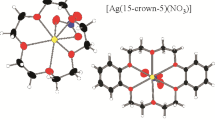Abstract
The alicyclic diol 2 is known to adopt five different types of crystallattice: the pure solid, cocrystalline compounds with water or certainphenols, and two different types of lattice inclusion system (helicaltubulates and ellipsoidal clathrates). Self-resolution only occurs onforming the helical tubulate inclusion compounds. Its close analogue2,7-bis(trifluoromethyl)tricyclo[4.3.1.13,8]un-decane-syn-2,syn-7-diol 4 was synthesised to examine the influence ofreplacing CH3- by CF3-groups. It no longer formslattice inclusion compounds but does form a cocrystalline solid withdimethyl sulfoxide (DMSO). Crystal structures of 4[C13H16O2F6,P21/c, a 7.8636(6), b 13.1020(7), c 25.319(2) Å, β101.526(4)°, Z 8, R 0.044] and (4)V_2.VD/MSO[(C13H16O2F6)2⋅C2H6SO,P212121, a 7.249(1), b 16.064(3),c 25.347(4) Å, Z 4, R 0.033] were determined. In solid diol 4 themolecules are linked through (–-O–-H)4 rings toproduce layers of chirally pure enantiomers but the net crystal structure,which comprises layers of alternating handedness, is achiral. In contrast,complexation of 4 with DMSO by means of two -–O-–H.O=Shydrogen bonds induces complete enantiomeric self-resolution.
Similar content being viewed by others
References
R. Bishop: in D. D. MacNicol, F. Toda and R. Bishop (eds.), Comprehensive Supramolecular Chemistry, Vol. 6, Ch. 4, pp. 85–115, Pergamon, Oxford (1996).
A. T. Ung, R. Bishop, D. C. Craig, I. G. Dance, and M. L. Scudder: J. Chem. Soc., Chem. Commun. 1012 (1991).
S. C. Hawkins, R. Bishop, I. G. Dance, T. Lipari, D. C. Craig, and M. L. Scudder: J. Chem. Soc., Perkin Trans. 2, 1729 (1993).
A. T. Ung, R. Bishop, D. C. Craig, I. G. Dance, and M. L. Scudder: Struct. Chem. 3, 59 (1992).
R. Bishop, D. C. Craig, A. Marougkas, and M. L. Scudder: Tetrahedron 50, 8749 (1994).
A. T. Ung, R. Bishop, D. C. Craig, I. G. Dance, and M. L. Scudder: Chem. Mater., 6, 1269 (1994).
A. Collet: TheHomochiral versus Heterochiral Packing Dilemma, in:M. Simonyi (ed.), Problems and Wonders of Chiral Molecules, pp. 91109, Akadémiai Kiadó, Budapest (1990).
J. Jacques, A. Collet, and S. H. Wilen: Enantiomers, Racemates, and Resolutions, Wiley, New York (1981).
R. Bishop, D. C. Craig, M. L. Scudder, A. P. Marchand, and Z. Liu: J. Chem. Soc., Perkin Trans. 2, 1295 (1995).
For discussion of this phenomenon: J. P. Glusker: Mol. Cryst. Liq. Cryst. 211, 75 (1992); see especially pp. 82–83; J.D. Dunitz and R. Taylor: Chem. Eur. J. 3, 89 (1997).
P. Murray-Rust, W. C. Stallings, C. T. Monti, R. M. Preston, and J. P. Glusker: J. Am. Chem. Soc. 105, 3206 (1983).
L. M. Mukherjee and E. Grunwald: J. Phys. Chem. 62, 1311 (1958).
P. Ramaiah, R. Krishnamurti, and G. K. S. Prakash: Org. Synth. 72, 232 (1994).
G. K. S. Prakash, R. Krishnamurti, and G. A. Olah: J. Am. Chem. Soc. 111, 393 (1989).
P. G. Gassman, J. A. Ray, P. G. Wenthold, and J. W. Mickelson: J. Org. Chem. 56, 5143 (1991).
I. G. Dance, R. Bishop, S. C. Hawkins, T. Lipari, M. L. Scudder, and D. C. Craig: J. Chem. Soc., Perkin Trans. 2, 1299 (1986).
R. M. H. Banda, I. G. Dance, T. D. Bailey, D. C. Craig, and M. L. Scudder: Inorg. Chem. 28, 1862 (1989).
J. de Meulenaer and H. Tompa: Acta Crystallogr. 19, 1014 (1965).
W. R. Busing, K. O. Martin, and H. A. Levy: ORFLS, Oak Ridge National Laboratory, Tennessee, U.S.A. (1962).
International Tables for X-Ray Crystallography, Vol. 4, J. A. Ibers and W. C. Hamilton (eds.), Kynoch Press, Birmingham (1974).
C. K. Johnson: ORTEPII, Oak Ridge National Laboratory, Tennessee, U.S.A. (1976).
A. D. Rae: RAELS. A Comprehensive Constrained Least Squares Refinement Program, University of New South Wales (1989).
S. C. Hawkins, M. L. Scudder, D. C. Craig, A. D. Rae, R. B. Abdul Raof, R. Bishop, and I. G. Dance: J. Chem. Soc., Perkin Trans. 2, 855 (1990).
F. H. Allen, J. E. Davies, J. J. Galloy, O. Johnson, O. Kennard, C. F. Macrae, E. M. Mitchell, G. F. Mitchell, J. M. Smith, and D. G. Watson: J. Chem. Inf. Comput. Sci. 31, 187 (1991).
K. Harata: Bull. Chem. Soc. Jpn. 51, 1644 (1978).
J. Iball, C. H. Morgan, and H. R. Wilson: Proc. Roy. Soc. (London), Ser. A, 302, 225 (1968).
I. Csöregh, A. Sjögren, M. Czugler, M. Cserzö, and E. Weber: J. Chem. Soc., Perkin Trans. 2, 507 (1986).
V. Gold, R. Stahl, W. N. Wassef, and R. Kuroda: J. Chem. Soc., Perkin Trans. 2, 477 (1986).
Y. Mazaki, N. Hayashi, and K. Kobayashi: J. Chem. Soc., Chem. Commun. 1381 (1992).
Z. I. Khazheeva, N. N. Petropavlov, and V. I. Simonov: Kristallografiya 26, 722 (1981).
F. H. Herbstein, M. Kapon, and S. Wasserman: Acta Crystallogr., Sect. B 34, 1613 (1978).
I. Csöregh, O. Gallardo, E. Weber, R. Pollex, and N. Dörpinghaus: J. Incl. Phenom. 20, 253 (1995).
A. Collet, M.-J. Brienne, and J. Jacques: Chem. Rev. 80, 218 (1980).
Author information
Authors and Affiliations
Rights and permissions
About this article
Cite this article
Bishop, R., Downing, G.a., Craig, D.C. et al. Enantiomeric Self-Resolution through Dimethylsulfoxide Complexation. Journal of Inclusion Phenomena 31, 145–160 (1998). https://doi.org/10.1023/A:1007958031910
Issue Date:
DOI: https://doi.org/10.1023/A:1007958031910




